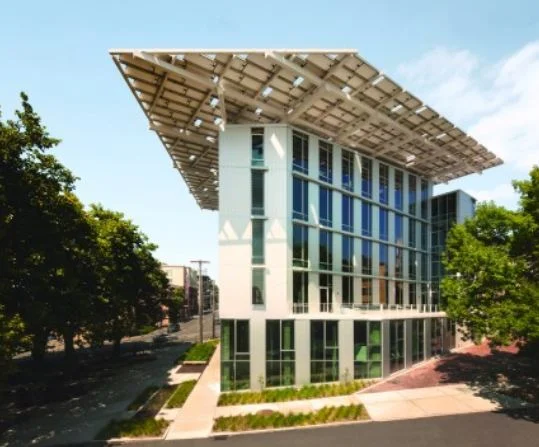Introduction Bullitt Center
Towering as a beacon of sustainability in Seattle, the Bullitt Center stands as a testament to innovative design and eco-conscious practices.
This six-story commercial building has redefined what it means to be sustainable, incorporating groundbreaking technologies and strategies that have earned it global recognition.
At the heart of the Bullitt Center's sustainability goals is its commitment to achieving net-zero energy consumption. The building's roof is adorned with an expansive array of solar panels that harness the power of the sun, generating more electricity than the building requires. This surplus energy is fed back into the grid, effectively making the Bullitt Center a net energy-positive structure.
Outlook Bullitt Center
Designed to minimize water consumption, the Bullitt Center features a sophisticated rainwater harvesting system. Rainwater is collected, filtered, and stored in a massive underground cistern, providing a sustainable and reliable source of water for various purposes within the building. This system reduces strain on municipal water supplies and promotes responsible water management.
The Bullitt Center prioritizes energy efficiency by employing advanced features such as automated windows that adjust to optimize natural light and ventilation. LED lighting fixtures, coupled with occupancy sensors, ensure minimal energy waste. The building's carefully designed envelope also minimizes heat loss, reducing the need for heating during colder months.
In its pursuit of sustainability, the Bullitt Center places a strong emphasis on materials and resource conservation. The construction materials used are largely salvaged, recycled, or locally sourced. Additionally, the building is designed for flexibility and adaptability, allowing for the repurposing or recycling of components at the end of their lifecycle.
One of the Bullitt Center's notable achievements is its Living Building Challenge certification, one of the most rigorous sustainability standards in the world. To earn this certification, the building had to demonstrate its adherence to strict criteria, including net-zero energy and water usage, healthy indoor environment, and the use of non-toxic materials.
The Bullitt Center serves as an educational resource, inviting visitors to experience its sustainable features firsthand. It houses a visitor center that showcases the building's green technologies and provides educational materials on sustainable practices, inspiring and empowering others to adopt similar principles in their own lives and projects.
The Bullitt Center stands as an extraordinary example of what is possible in sustainable architecture. By challenging conventional norms and pushing boundaries, it inspires a global shift toward more environmentally conscious buildings. The Bullitt Center's achievements in net-zero energy, water conservation, and material sustainability make it a trailblazer in the quest for a greener and more sustainable future.
Fact and Data Bullitt Center
- The Bullitt Center generates more electricity than it consumes, making it a net energy-positive building.
- The rainwater harvesting system provides a sustainable source of water, reducing reliance on municipal supplies.
- Automated windows and LED lighting fixtures optimize natural light and minimize energy waste.
- The building utilizes salvaged, recycled, and locally sourced construction materials.
- The Bullitt Center is certified under the Living Building Challenge, meeting stringent sustainability standards.
- The building includes a visitor center that educates and inspires visitors on sustainable practices.
- The Bullitt Center serves as a global example of pushing boundaries in sustainable architecture.
- The building inspires a shift towards environmentally conscious buildings and a greener future.


